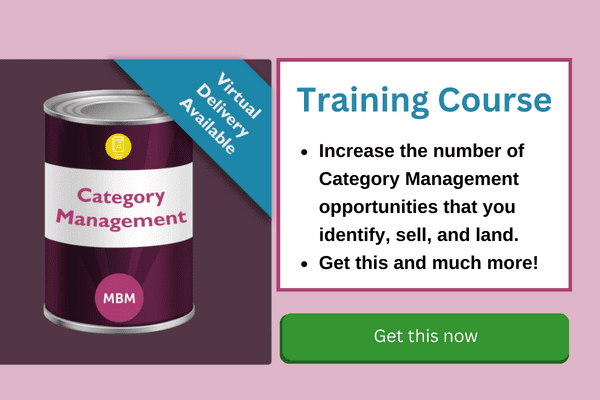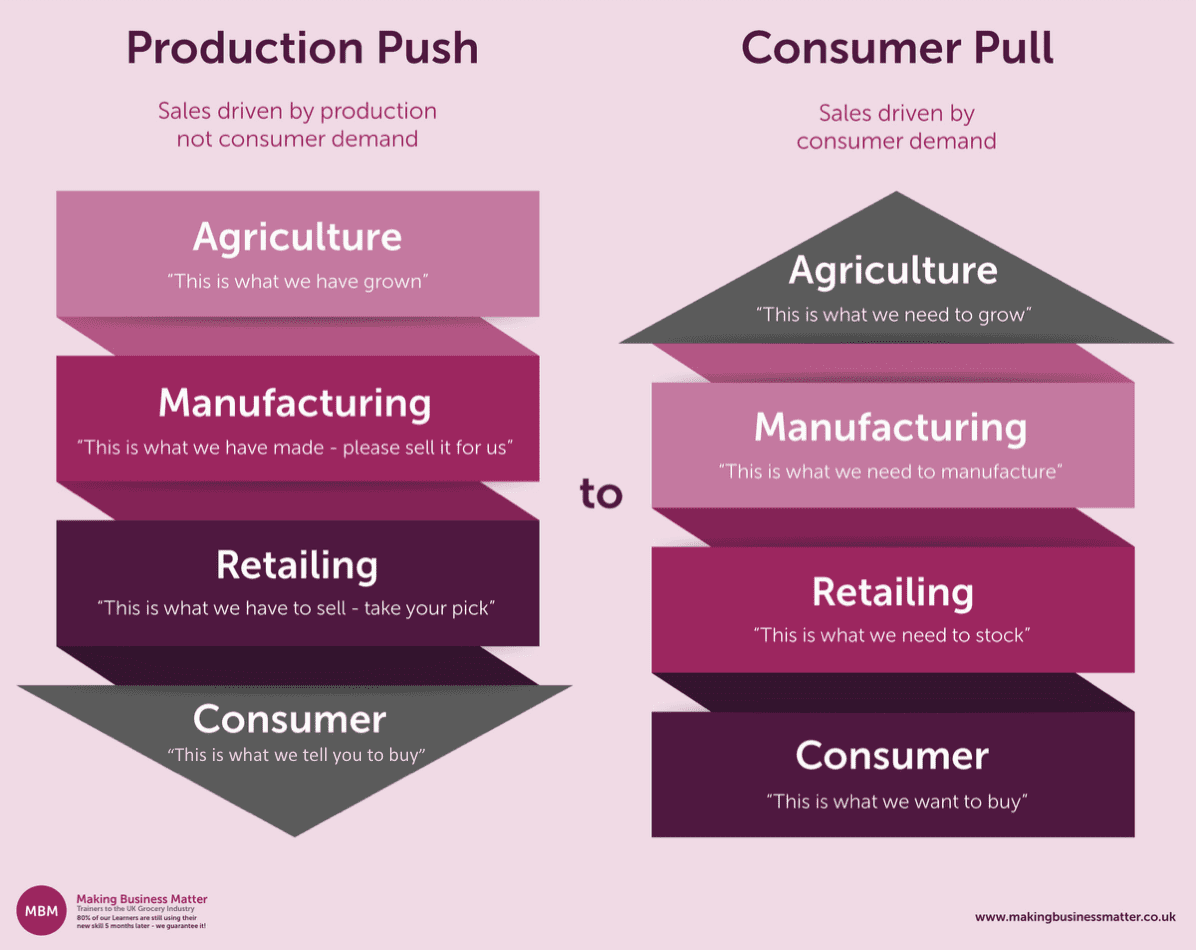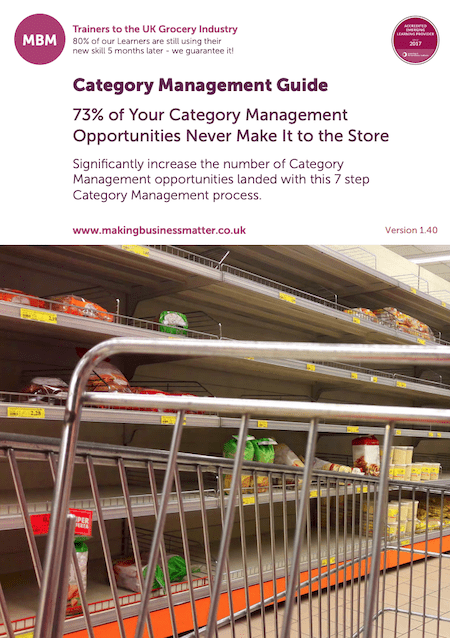Learn How to Bake a Better ‘Category’ Pie
Category Management is a means of organising product groups to meet shopper needs and to create greater procurement efficiencies.
The retailing concept of Category Management originated in the late 1980s. It followed the research of Brian F. Harris, a former professor at the University of Southern California. It changed the way retailers and suppliers worked together and transformed the way in which products were merchandised and promoted in-store.
Instead of suppliers competing with each other, Category Management encouraged suppliers to work together.
Furthermore, the focus shifted to the consumer. Subsequently, this meant that decisions were no longer made absent the shopper, but with the shopper at the core of any decision.
Category Management should no longer occur in isolation once every six months. Working together is part of day-to-day product management. There should be a relationship of trust and the sharing of data and ideas. Long gone are the days of oppositional relationships between suppliers and retailers. Yes, supermarkets will always demand the best cost. The best quality. The latest innovation. Category Management challenged why. The answer was no longer simply to make money. It was first to please the shopper because that made money.

What is Category Management?
Historically, retail categories would contain lots of brands from different suppliers. The situation would arise that every time brand X promoted its products, the sales of brand Y would go down. One benefited at the expense of the other. In short, they were competing with each other. There was, therefore, no net gain for the retailer.
For the first time, the retailer grouped the range of products offered for sale together. The groups were based on product similarities and the consumer need they met. The management of these ‘product categories’ treats them as a Strategic Business Unit (SBU), and no longer as stand-alone products or brands.
The example below is of fruit. The traditional way to manage fruit was in categories. An apple category. An orange category, and so on. Category Management pushed the thought that the product met shopper needs.
Therefore the next logical step was to ask that shopper. When they replied with a resounding, ‘We don’t get it beyond Everyday Fruit, Special Fruit and Strange Fruit, the Buyer had to stop what they were doing. If the shopper only knew these categories, then it made sense that they bought some everyday fruit, sometimes special fruit, and infrequently strange fruit. That then meant that if you were to promote 50p off apples and a similar deal off of oranges, then you were simply moving the money around.
New Way Forward?

The new way forward in Category Management is to manage categories as consumers see them. Furthermore, to promote in a way that increases the whole spend not decreases it. Clearly, this means having objectives for each promotion and knowing its impact on the surrounding categories, as the consumer sees them. So, rather than promoting apples and oranges. Alternatively, promote apples at, ‘Buy 2 packs for 50p off’ to encourage trading up, and single Finest oranges a 25p off, to encourage trial.
The retailer now monitors the profitability of the whole category and not just individual products. ‘Canned Soup’, for example, is one unit. This process allows mutual profits to be maximised and, moreover, it better meets consumer needs.
I’ve also Heard it’s Dead
We hear this a lot at MBM. Usually from those where Category Management has always alluded them. Largely because by considering it dead, they can skip the bit in the middle where they had to embrace it. If Category Management is about meeting the shoppers’ needs then two things are true. Firstly, it is very much alive because if you don’t meet the shopper’s needs your business is terminal. Secondly, it is very much dead because whilst people don’t go and do ‘Category Management’ anymore, it is because it is business as usual.
Sticky Learning ® is 7 times more effective than 1-day training courses. Plus, you will get a Chain of Evidence proving your Return on Investment. Discover soft skills training that changes behaviours long term.

What is Best Practise?
Best practise category management is about learning from the last 25 years of Category Management. Here at MBM, we have over 100 years of experience, so we are happy to share our Do’s and Don’ts:
- Don’t confuse the customer and the consumer. Use alternative terms that make it very clear. The shopper, the preparer, and the eater.
- Don’t use terminology that the shopper would not understand. For example, if you use a term internally to describe a range, or a product, as yourself why. Is it because it has no role in the category or needs to be adapted to have a roll. Fruit suppliers often describe apples and pears as ‘top fruit’, yet the shopper would have no idea what this is.
- Don’t fall into the trap of not knowing how to measure the effectiveness of a Category Manager. Measure yourself on your landing rate. Find out how to do that with the Category Manager Job Description.
- Do work in-store because the last ‘100 yards’ of the sell, is crucial. You’ll find out so much about your products and how the staff feel in-store about putting them on the shelf, and what shoppers say.
- Do learn from others. We are busy creating the best category tips from the most influential category managers on the planet. Read their category tips and maybe share yours.
- Do understand how to create a SMART category target. In our experience, 99% of people have heard of a S.M.A.R.T target. Only 1% can create one.
The Role of Category Management
Category Management is not something to only consider every six months. It should never be the last minute afterthought ahead of an important meeting. It is a continuous process. Rushing it will only waste time and money. It will only lead to false insights into the category and its shoppers.
Here at MBM, we have seen many companies experiment with Category Management. They might buy some data and produce some charts and tables for a presentation. However, it will often result in flaky interpretations. Insight shaped to a specific agenda. Typically, it is still the thinking ‘of old’.
In short, Production Push mentality still hasn’t moved to Consumer Pull.
To put it another way, the consumer is not at the centre of decision making. The Category Management Model below explains how this has changed over time:

Historically, the supply chain decided what they wanted to make or grow. Sales were driven by production. Or, as we like to call it, a ‘Production Push’.
Now, by using data to drive strategy, this has changed. Decisions made by Category Managers are based on two key things:
- Efficiency
- Meeting a consumer need
Consequently, consumer demand now drives sales. We like to call this ‘Consumer Pull’. Through data, consumers are telling us what they want to buy. It is the role of the supply chain to interpret and respond to this.
Download Our Free Competency Framework
Our frameworks draw upon our shared 100+ years of experience of the UK Grocery Industry. Simply add your email to the box below and start to measure your performance:
Category Management vs. Marketing
Now we know what Category Management is, we need to appreciate the differences to its sister ‘Marketing’.
It is often seen as an analytical difference. Category Management is about understanding data and facts to drive change. By contrast, shopper marketing is more about understanding emotions or motivations.
True Category Management, whilst data led, is also about mindset. Category Managers need to live in shoppers, preparers and eaters shoes. This helps to identify and understand category opportunities. Remember, these insights help drive the whole category.
In the age of big data, we are both fortunate and unfortunate in the amount of information we have available. At no other time have we had access to so much information. Retailers have got wise to this giving suppliers ‘the reins’ on data and research acquisition. Moreover, they are also involved in analysis and insight generation. This allows their expertise about a specific product category to be leveraged. Their knowledge and resources (people) are hugely valuable to the retailer. It must, however, be a two-way relationship. Regardless of the quality of their insights, suppliers and retailers need to work together.
The Art of Negotiation
Imagine a pie. The pie is a category and is often supplied by many companies. Different sized slices make up all of the Category’s suppliers. Each of these will have different requirements. It is the role of the National Account Management (NAMs) to negotiate the size of their slice. This will fluctuate over time as they win and lose deals in tenders. Supply base rationalisations and changes in distribution shares will also play a role. The pie, stays roughly the same size in terms of sales value or volume.

Differing Agendas
The Category Manager has a different agenda to the NAM, albeit still on the same payroll. This is because the Category Manager has the potential to grow the whole pie.
They are experts in the requirements of their Category. Moreover, they know how to exploit opportunities to achieve supplier excellence.
Their role is to look to grow the whole category. This should be beyond the 5-10% (+/-) fluctuation in the supplier’s slice size that you would expect to see over a 3 year period. A great Category Manager has earnt the trust of the Buyer because they have shown an independent perspective. They have proven to champion the Shopper. Even if it means to the possible detriment of their company. They understand the importance of trust and building a long-term category plan.
Invest for Mutual Benefit
It’s a brave company that invests in its people to grow their competitor’s sales …or is it?
This is the key issue with good Category Management. It is why some companies see it as a reason not to adopt its core principals. Yet, it is important to look beyond this. It will not only deliver sales and profit increases for all involved. Good Category Management will often bring other immeasurable benefits.
For instance, Category Captaincy and such associated titles. These are where a supplier is recognised and rewarded for their efforts.
At a basic level, they can become the ‘first port of call’ for advice on category direction for the retailer. They could even become a ‘preferred supplier’ of new launches., becoming part of the inner circle of trust. This is where retailers may give a ‘heads up’ on pending opportunities and tenders.
By now you should have a clearer understanding of What is Category Management. You may start to consider your next steps:
- Are you new to Category Management? Do you want to further understand What Category Management is and what great looks like? Assess your category using our scorecard.
- Would you like to generate sustainable growth for your category? How about investing in a 1/2 day Masterclass?
- Already in Category Management? Do you want to improve your Category Manager Training? How about learning some new Category Management Techniques? Take a look at our Category Management training (see link above).
Download Our Free Category Management Guide

Are You Concerned That You Are Using the Same Promotional Mechanics That You Did Last Year and You Still Have No Idea if They Make Money?
Discover how to design more effective promotional plans that are profitable with a known ROI.
This guide looks at how more effective promotional planning can be applied in today’s UK Supermarkets. It will provide you with new approaches, fresh thinking and thought provocation to ensure you keep ahead of your competitors. With 7 pragmatic tips, you can take away and use today.




